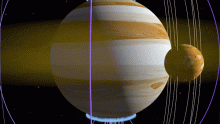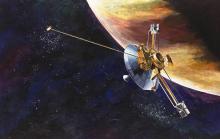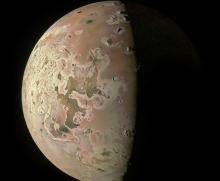Listen to today's episode of StarDate on the web the same day it airs in high-quality streaming audio without any extra ads or announcements. Choose a $8 one-month pass, or listen every day for a year for just $30.
You are here
New Moons
The space around Earth is getting crowded — thousands of satellites orbit our planet. The space around Jupiter is getting crowded, too — with natural satellites. A recent spate of discoveries has brought the number of known moons to 95 — more than any other planet in the solar system. And many more probably are just waiting to be discovered.
The new moons are small — no more than about five miles in diameter. And most of them are a long way from Jupiter — they take at least 11 months to make a single orbit.
The discoveries were made by a group led by Scott Sheppard of the Carnegie Institution for Science. Sheppard’s been involved in the discoveries of 70 of Jupiter’s moons. It takes careful observations to find the moons because they’re small, faint, and far away from Jupiter.
Three of the newly found moons orbit in the same direction as Jupiter’s rotation on its axis. They probably are chips of larger bodies that were blasted apart by big impacts.
The other new moons orbit in the opposite direction. They may have been asteroids that were captured by Jupiter when they wandered close to the solar system’s largest planet.
The new discoveries vaulted Jupiter past Saturn, which has 83 known moons, although its numbers are likely to swell, too. And a recent study said that Saturn might have had another big moon that was pulverized by Saturn’s gravity, forming the planet’s rings. More about that tomorrow.
Script by Damond Benningfield





